How to Clean Legos: A Comprehensive Guide
Cleaning Legos is essential to preserve their quality and ensure they last for years to come. In this comprehensive guide, I will share valuable tips and techniques on how to effectively clean and maintain your Lego collection.
- Regular cleaning is important to remove dirt, dust, and grime from Lego bricks and maintain their appearance.
- There are various methods for cleaning Legos, including hand washing, using a washing machine or dishwasher, and utilizing an ultrasonic cleaner.
- Before cleaning, it is crucial to separate stickered pieces and electrical parts to prevent any damage.
- Gentle soap or detergent and warm water should be used for hand washing Lego bricks.
- Avoid using high temperatures or heat sources for drying Lego bricks to prevent damage.
With these tips and techniques, you can keep your Lego collection clean and well-maintained, ensuring the longevity and enjoyment of your beloved bricks.
The Importance of Cleaning Lego Bricks
Keeping Lego bricks clean is crucial for maintaining their aesthetic appeal and ensuring they fit together properly. Let’s explore the reasons why regular cleaning is essential and the best ways to clean different types of Lego sets.
Over time, Lego bricks can accumulate dirt, dust, and grime, which not only affects their appearance but also hampers their functionality. Dust and debris can get lodged in between the interlocking studs, making it difficult for the bricks to connect securely. Regular cleaning not only improves the overall look of your Lego sets but also ensures that they can be assembled and disassembled with ease.
To clean Lego bricks, there are various methods you can choose from. For general cleaning, hand washing is a popular option. It involves using a gentle soap or detergent and warm water. This method is suitable for most Lego sets and helps remove surface dirt and grime effectively. However, for stickered pieces or electrical parts, it is important to separate them before cleaning to avoid damaging them.
An alternative to hand washing is using a washing machine or dishwasher. This method is suitable for larger quantities of Lego bricks and can save time and effort. However, it is essential to place the bricks in a laundry bag or a dishwasher-safe container to prevent damage. Selecting the appropriate settings, such as a gentle cycle or low-temperature wash, is crucial to protect the bricks.
For deep cleaning, an ultrasonic cleaner can be used. This method is particularly effective for removing stubborn dirt and grime from hard-to-reach areas of the bricks. An ultrasonic cleaner uses sound waves to create tiny bubbles that gently clean the Lego pieces. However, it is important to choose a suitable cleaning solution and follow the manufacturer’s instructions carefully to avoid any potential damage.
| Type of Cleaning | Advantages | Disadvantages |
|---|---|---|
| Hand Washing | Effective for surface cleaning, suitable for most Lego sets | Time-consuming for large quantities of bricks |
| Washing Machine/Dishwasher | Time-saving for large quantities of bricks | Potential for damage if not done correctly, unsuitable for stickered pieces or electrical parts |
| Ultrasonic Cleaner | Effective for deep cleaning, reaches hard-to-reach areas | Requires a suitable cleaning solution and careful handling to avoid damage |
After cleaning, it is crucial to ensure the Lego bricks are properly dried before storage. Avoid using high temperatures or heat sources, as this can cause the bricks to warp or become discolored. Let them air dry naturally or use a soft cloth to gently pat them dry.
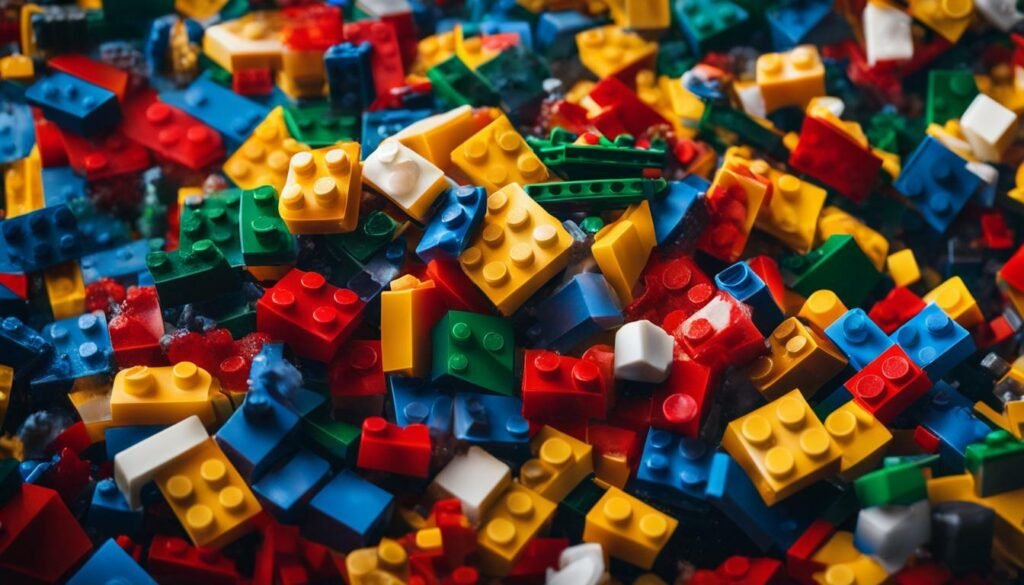
Summary
- Regular cleaning of Lego bricks is essential for maintaining their aesthetic appeal and functionality.
- Methods such as hand washing, using a washing machine or dishwasher, and using an ultrasonic cleaner can be employed.
- Separate stickered pieces and electrical parts before cleaning.
- Avoid high temperatures or heat sources for drying Lego bricks.
By following these cleaning tips, you can ensure that your Lego sets remain in optimal condition, ready for countless hours of building and playtime.
Preparing Lego Bricks for Cleaning
Before diving into the cleaning process, it’s crucial to prepare your Lego bricks properly to ensure optimal results. Let’s go through the necessary steps to get your Legos ready for a thorough cleaning.
First, it’s important to sort and separate any stickered pieces and electrical parts from the rest of your Lego collection. Stickered pieces can get damaged or lose their adhesive properties when submerged in water, so it’s best to set them aside for manual cleaning. Similarly, electrical parts should be removed to prevent any damage to their delicate components.
Once you have sorted out the stickered and electrical pieces, it’s time to address the issue of loose dust and debris. Use a soft-bristled brush or a microfiber cloth to gently remove any superficial dirt from the Lego bricks. This step is essential as it helps to prevent scratching the bricks during the cleaning process and ensures that the cleaning solution can penetrate deeper.
Gently clean the dusty Lego bricks by following these steps:
- Prepare a cleaning solution by mixing a mild soap or detergent with warm water in a container. Avoid using harsh chemicals or abrasive cleaners, as they can damage the bricks.
- Place the Lego bricks in the cleaning solution and let them soak for about 15-20 minutes. This allows the solution to loosen dirt and grime.
- Using a soft-bristled brush or a toothbrush, gently scrub the Lego bricks to remove any remaining dirt. Pay extra attention to crevices and hard-to-reach areas.
- Rinse the Lego bricks thoroughly under lukewarm water to remove any soap residue.
- Once clean, place the Lego bricks on a clean towel or a drying rack and allow them to air dry completely. Avoid using high temperatures or heat sources for drying, as this can damage the bricks.
After your Lego bricks are dry, they are ready to be stored or used again. Proper storage in airtight containers or plastic bags will help prevent dust and dirt from accumulating, extending the lifespan of your Lego collection. Regular cleaning and maintenance will keep your Legos looking their best and ensure countless hours of fun building and playing.
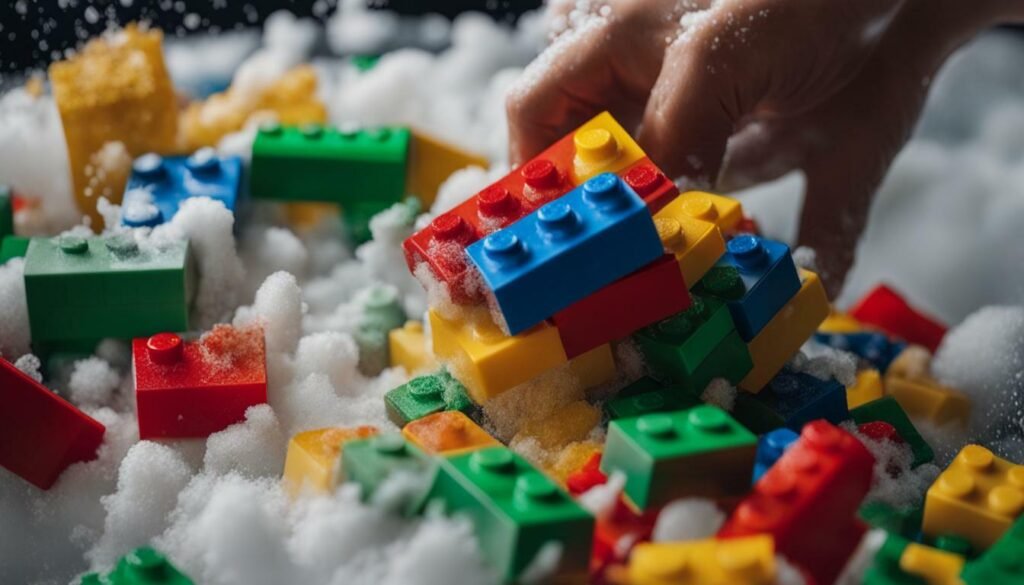
Hand Washing Lego Bricks
Hand washing is one of the safest and most effective methods to clean Lego bricks. Let me walk you through the step-by-step process of hand washing and share some handy hacks to make the task easier.
To start, gather all the Lego bricks that need cleaning. Fill a basin or sink with warm water and add a few drops of gentle soap or detergent. Swirl the water to create a soapy solution.
Next, immerse the Lego bricks in the soapy water. Use a soft-bristle brush or cloth to gently scrub each brick, paying extra attention to any visible dirt or stains. For hard-to-reach places or intricate details, use a toothbrush or cotton swab.
Once the bricks are clean, rinse them thoroughly under running water to remove any soap residue. Shake off excess water or pat the bricks dry with a clean towel. Avoid using high temperatures or heat sources for drying, as this can cause damage.
Here are some handy hacks to make the hand washing process even more efficient:
- Sort the Lego bricks by color or size before cleaning to make it easier to find specific pieces later.
- If you have a large number of bricks to clean, consider using a mesh laundry bag to contain them. This will prevent smaller pieces from getting lost or tangled during the washing process.
- For stubborn stains or grime, create a paste using baking soda and water. Apply the paste to the affected areas, let it sit for a few minutes, then scrub and rinse as usual.
- To speed up the drying process, you can use a fan or air dry the bricks outdoors. Just make sure to keep them in a shaded area to avoid sun damage.
| Pros | Cons |
|---|---|
| Safe and gentle cleaning method | Time-consuming, especially for large collections |
| Allows for thorough cleaning of each individual brick | Requires manual effort and attention to detail |
| Can be done with readily available household items | Not suitable for heavily soiled or greasy bricks |
Using a Washing Machine or Dishwasher
If you have a large collection of Lego bricks, using a washing machine or dishwasher can be a time-saving option. Discover how to safely clean your Lego bricks using these appliances and understand the merits and drawbacks of each method.
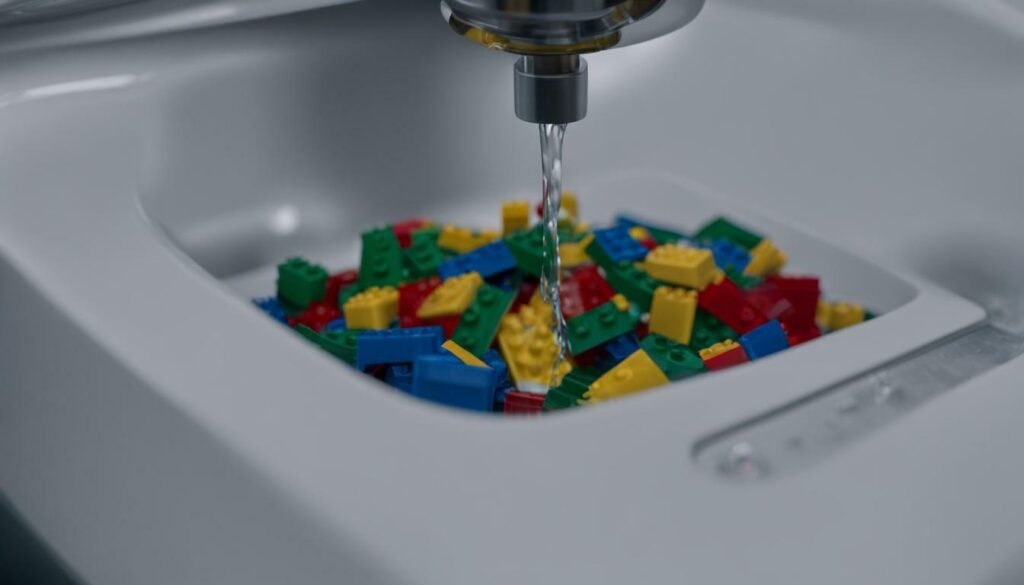
Before you start, it’s important to note that not all Lego bricks are suitable for machine cleaning. It is recommended to remove any stickered pieces or electrical parts as these can be damaged by the intense agitation or heat of the appliances. Additionally, it is advisable to place the Lego bricks in a laundry bag or a dishwasher-safe container to prevent them from getting trapped in the machine’s mechanisms.
When using a washing machine, set it to a delicate or gentle cycle with cold or lukewarm water. Avoid using hot water as it may cause the bricks to warp. It’s also recommended to add a small amount of mild detergent to the wash, but be cautious not to use too much as excessive suds can be difficult to rinse off. Once the cycle is complete, remove the Lego bricks from the machine and allow them to air dry thoroughly before storing them.
If you prefer using a dishwasher, place the Lego bricks in a dishwasher-safe container or a mesh laundry bag to prevent them from tumbling around and potentially getting damaged. Select a low-temperature setting and avoid using any dishwasher detergent with added chemicals or abrasives. After the cycle is finished, take out the Lego bricks and let them air dry completely. Ensure they are dry before storing them away to prevent any moisture-related damage.
| Method | Merits | Drawbacks |
|---|---|---|
| Washing Machine | – Time-saving for large collections – Good for general cleaning – Can reach smaller crevices | – Risk of damage to stickered pieces or electrical parts – Potential warping with hot water – Excessive suds may be difficult to rinse |
| Dishwasher | – Convenient for large collections – Suitable for general cleaning – Can reach smaller crevices | – Risk of damage to stickered pieces or electrical parts – Potential warping with high temperatures – Avoid using harsh dishwasher detergents |
Both the washing machine and dishwasher methods can save you time and effort when cleaning your Lego bricks, especially if you have a large collection. However, it’s important to be cautious and follow the guidelines to prevent any damage to your bricks. Regular maintenance and proper cleaning methods will help keep your Lego bricks in excellent condition for more building adventures!
Using an Ultrasonic Cleaner for Deep Cleaning
An ultrasonic cleaner can be a game-changer when it comes to deep cleaning your Lego pieces. Discover how this advanced cleaning method works and learn the steps to achieve a thorough clean using an ultrasonic cleaner.
Ultrasonic cleaning utilizes the power of high-frequency sound waves to create tiny bubbles in a cleaning solution. These bubbles implode upon contact with the Lego pieces, creating microscopic shockwaves that dislodge dirt, dust, and grime from even the tiniest crevices. The process is gentle yet effective, ensuring a comprehensive clean without causing any damage to the Lego bricks.
To deep clean your Lego pieces using an ultrasonic cleaner, start by preparing a suitable cleaning solution. Choose a mild detergent or specialized Lego cleaning solution that is compatible with your ultrasonic cleaner. Fill the cleaner’s tank with the appropriate amount of solution, following the manufacturer’s instructions.
Next, place your Lego pieces in a suitable container or basket that fits inside the ultrasonic cleaner. Ensure that the pieces are fully submerged in the cleaning solution, but avoid overcrowding the container to allow for optimal cleaning. Start the ultrasonic cleaner and let it run for the recommended duration, typically ranging from 5 to 10 minutes.
After the cleaning cycle is complete, remove the Lego pieces from the ultrasonic cleaner and rinse them thoroughly with clean water. Gently pat them dry with a soft, lint-free cloth or allow them to air dry naturally. Finally, inspect your Lego pieces to ensure they are completely clean before storing them or using them for your next building project.
| Benefits of Using an Ultrasonic Cleaner |
|---|
| Thorough Cleaning: Ultrasonic cleaners can reach into the smallest crevices, ensuring a deep clean that is difficult to achieve through other methods. |
| Efficiency: The cleaning process is quick, with most cycles lasting only a few minutes, saving you valuable time. |
| Gentle on Bricks: Unlike aggressive cleaning methods that may cause damage, ultrasonic cleaning is gentle and safe for your Lego pieces. |
| Versatility: Ultrasonic cleaners can be used to clean various other items, such as jewelry, eyeglasses, and small metal parts. |
“Ultrasonic cleaning is a revolutionary method that ensures a thorough clean for your Lego pieces, even in hard-to-reach spots. It’s a fantastic solution for maintaining the cleanliness and longevity of your Lego collection.”
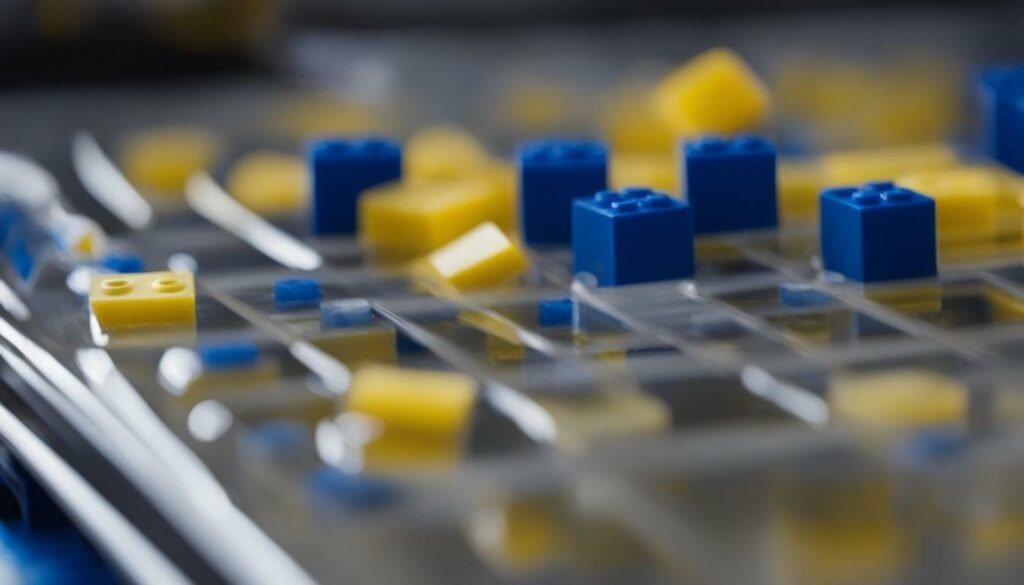
Deep cleaning your Lego pieces with an ultrasonic cleaner can give them a new lease on life, restoring their shine and ensuring they are free from dirt and grime. This advanced cleaning method, combined with proper drying and storage, will help you maintain the quality of your Lego bricks for years to come.
Drying Lego Bricks
Properly drying Lego bricks is vital to maintain their quality and prevent potential damage. Let’s explore the best practices and innovative hacks for drying your Lego bricks safely.
- After cleaning the Lego bricks, gently pat them dry with a soft, absorbent towel or cloth. Avoid rubbing the bricks, as this can cause scratches or damage.
- Leave the Lego bricks to air dry completely in a well-ventilated area. Placing them near a fan or in a sunny spot can help speed up the drying process.
- Avoid using high temperatures or heat sources, such as a hairdryer or radiator, as this can warp or melt the bricks. It’s essential to be patient and allow the bricks to dry naturally.
- If you’re in a hurry or want to ensure thorough drying, consider using a moisture-absorbing agent like silica gel packets. Place the Lego bricks in an airtight container with the silica gel packets, and they will help absorb any remaining moisture.
Remember, rushing the drying process can lead to damage, so it’s crucial to allow sufficient time for complete drying. Once the Lego bricks are dry, they are ready to be stored and enjoyed for future building adventures.
Table: Drying Methods for Lego Bricks
| Method | Pros | Cons |
|---|---|---|
| Air drying | Safe and gentle method, suitable for most Lego bricks. | Requires more time for drying. |
| Using a fan | Helps speed up the drying process. | May not be suitable for delicate or intricate Lego pieces. |
| Using silica gel packets | Efficient in absorbing moisture and ensuring thorough drying. | Requires silica gel packets and an airtight container. |
“Properly drying Lego bricks after cleaning is crucial to maintain their quality and prevent damage. Rushing the process can lead to warped or melted bricks. Take your time and allow the bricks to air dry naturally or use moisture-absorbing agents like silica gel packets to ensure complete drying.” – LEGO Cleaning Expert

By following these drying methods and taking care of your Lego bricks, you can keep them in optimal condition for years to come. The small investment of time and effort in proper drying will pay off with pristine, ready-to-build bricks whenever inspiration strikes.
Storage and Maintenance Tips
Cleaning your Lego bricks is just the beginning of proper care. Discover essential storage and maintenance tips to ensure your Lego collection stays in excellent condition and ready for endless building adventures.
Proper storage is crucial to prevent damage and loss of Lego pieces. Investing in storage containers with dividers or compartments can help keep your bricks organized and easily accessible. Sorting your Lego sets by theme or color can also make it easier to find the pieces you need for specific builds.
Make sure to keep your Lego bricks away from direct sunlight, as prolonged exposure can cause the colors to fade. Additionally, avoid storing them in areas with extreme temperatures or high humidity, as this can affect the quality of the bricks over time.
Regular maintenance is also important to keep your Lego collection in top shape. Inspect your bricks periodically for any signs of wear or damage, such as cracks or loose fittings. Replace any damaged pieces to maintain the structural integrity and aesthetic appeal of your Lego sets.
| Maintenance Tips | Benefits |
|---|---|
| Regularly dust your Lego sets using a soft brush or microfiber cloth. | Prevents the accumulation of dust and maintains the overall cleanliness of the bricks. |
| Avoid using harsh cleaning agents or abrasive materials that can damage the surface of the bricks. | Preserves the integrity and color of the Lego pieces. |
| Store instruction booklets separately in a safe place to keep them in good condition for future use. | Ensures you have the necessary instructions for rebuilding sets or troubleshooting. |
| Consider adding silica gel packs to your storage containers to help absorb moisture and prevent mold growth. | Protects against humidity and maintains the longevity of your Lego bricks. |
By following these storage and maintenance tips, you can preserve the quality of your Lego collection and enjoy countless hours of creative building without worrying about damage or disarray.

I understand that you may have some questions about cleaning your Lego bricks. Here are answers to some commonly asked questions:
- Can I use bleach to clean Lego bricks?
No, it is not recommended to use bleach or any harsh chemicals on Lego bricks as it can damage the plastic. Stick to using gentle soap or detergent with warm water for hand washing, or follow the manufacturer’s instructions for machine cleaning. - How often should I clean my Lego sets?
The frequency of cleaning will depend on factors such as usage, storage conditions, and the level of dirt or grime on the bricks. As a general guideline, it is a good idea to clean Lego sets every few months to keep them in good condition. - Can I use a hairdryer to dry the Lego bricks?
It is best to avoid using a hairdryer or any other high-temperature heat source to dry Lego bricks. The heat can warp or deform the plastic. Instead, air drying at room temperature is recommended. You can place the bricks on a towel or use a fan to speed up the drying process. - How can I remove sticky residue from Lego bricks?
If you have sticker residue on your Lego bricks, you can try using a mild adhesive remover or rubbing alcohol. Apply a small amount to a cloth or cotton swab and gently rub the affected area. Be careful not to use too much liquid, as it can seep into the bricks and damage them.
Remember, when cleaning Lego bricks, always handle them with care and take the necessary precautions to avoid damage. By keeping your Lego bricks clean and well-maintained, you can ensure their longevity and continued enjoyment. If you have any specific concerns or questions, it is always best to refer to the Lego manufacturer’s instructions or seek advice from a professional.
| Question | Answer |
|---|---|
| Can I use bleach to clean Lego bricks? | No, it is not recommended to use bleach or any harsh chemicals on Lego bricks as it can damage the plastic. Stick to using gentle soap or detergent with warm water for hand washing, or follow the manufacturer’s instructions for machine cleaning. |
| How often should I clean my Lego sets? | The frequency of cleaning will depend on factors such as usage, storage conditions, and the level of dirt or grime on the bricks. As a general guideline, it is a good idea to clean Lego sets every few months to keep them in good condition. |
| Can I use a hairdryer to dry the Lego bricks? | It is best to avoid using a hairdryer or any other high-temperature heat source to dry Lego bricks. The heat can warp or deform the plastic. Instead, air drying at room temperature is recommended. You can place the bricks on a towel or use a fan to speed up the drying process. |
| How can I remove sticky residue from Lego bricks? | If you have sticker residue on your Lego bricks, you can try using a mild adhesive remover or rubbing alcohol. Apply a small amount to a cloth or cotton swab and gently rub the affected area. Be careful not to use too much liquid, as it can seep into the bricks and damage them. |
Remember, when cleaning Lego bricks, always handle them with care and take the necessary precautions to avoid damage. By keeping your Lego bricks clean and well-maintained, you can ensure their longevity and continued enjoyment. If you have any specific concerns or questions, it is always best to refer to the Lego manufacturer’s instructions or seek advice from a professional.
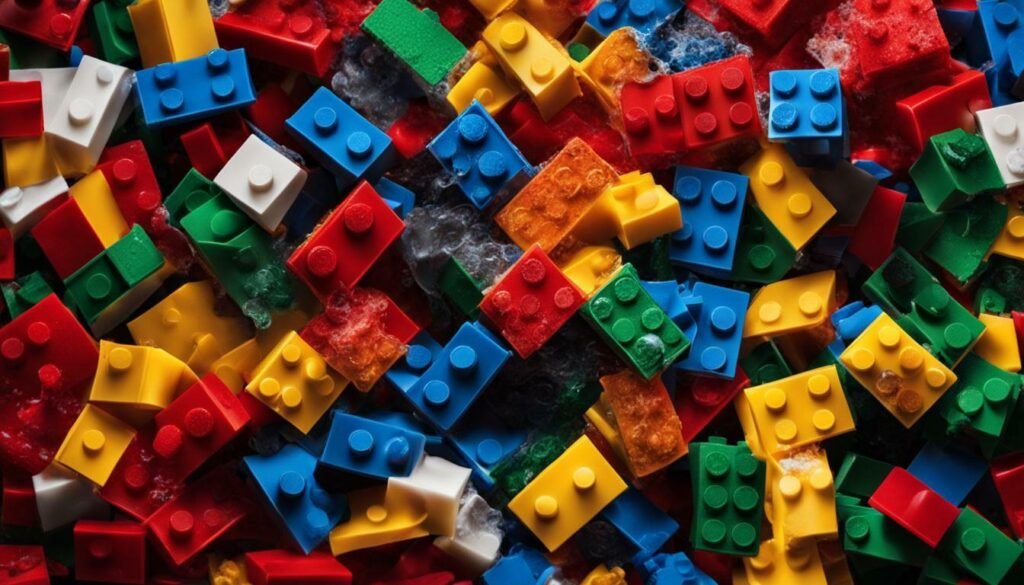
Congratulations! You now have a comprehensive understanding of how to clean and maintain your Lego bricks. By following the tips and techniques shared in this article, you can ensure your Lego collection remains in perfect shape for years to come.
Cleaning Lego bricks is an important task to keep them in good condition and remove dirt, dust, and grime. There are several methods you can use for cleaning Lego bricks, depending on your preference and the level of dirtiness.
Hand washing is a gentle and effective method. Use warm water and a gentle soap or detergent to clean the bricks. Remember to sort and separate stickered pieces and electrical parts before washing. It is also important to remove loose dust and debris before starting the cleaning process.
You can also consider using a washing machine or dishwasher to clean your Lego bricks. However, be cautious and use a laundry bag or dishwasher-safe container to prevent any damage. Select the appropriate settings and avoid high temperatures that can harm the bricks.
If you need a deep clean, an ultrasonic cleaner can be a great option. It uses sound waves to remove stubborn dirt and grime. Be sure to select the right cleaning solution for the cleaner to avoid any damage to the bricks.
Lastly, drying and proper storage are essential for maintaining the quality of your Lego bricks. Avoid high temperatures or heat sources that can cause damage. Allow the bricks to dry naturally before storing them in proper containers, separating different Lego sets.
By following these cleaning and maintenance tips, you can ensure your Lego collection remains in top-notch condition, ready to be enjoyed for many years to come.
FAQ
How often should I clean my Lego bricks?
It is recommended to clean Lego bricks regularly to keep them in good condition. The frequency of cleaning will depend on how often the bricks are used and the level of dirt and grime accumulated.
Can I use high temperatures to dry Lego bricks?
No, it is important to avoid using high temperatures or heat sources for drying Lego bricks as this can damage them. It is best to let them air dry naturally or use a low heat setting if using a dryer.
Can I clean stickered Lego pieces?
Yes, stickered Lego pieces can be cleaned, but they should be handled with care. It is important to avoid rubbing the stickers vigorously to prevent damage.
How long does the cleaning process take?
The time required to clean Lego bricks can vary depending on the number of bricks being cleaned. It can take anywhere from 20 minutes to several hours.
Can I use any soap or detergent for hand washing Lego bricks?
It is recommended to use a gentle soap or detergent that is suitable for cleaning delicate items. Harsh chemicals or abrasive cleaners should be avoided, as they can damage the Lego bricks.
Are electrical Lego parts safe to clean?
Electrical Lego parts, such as motors or lights, should not be submerged in water or cleaned using liquid solutions. It is best to wipe them with a damp cloth or use a cleaning method specifically recommended for electrical components.
Do I need to dry Lego bricks before storing them?
Yes, it is important to ensure that Lego bricks are completely dry before storing them. Moisture can lead to mold growth or damage the bricks over time. Proper drying is essential for maintaining the quality of the Lego bricks.











